What Do The '+' And '-' Stand For On Your Car's Transmission Gear Selector?
If you've spent any time in the front of a vehicle that uses an automatic transmission, whether driving or as a passenger, you've likely also spent some time absent-mindedly studying the various numbers and symbols on the gear selector or shifter. Most of it seems pretty self-explanatory (D for Drive, N for Neutral, etc), provided you're familiar with the process of driving.
But what's with the little plus (+) and minus (-) symbols on there? An automatic doesn't need much beyond Drive, Park, Neutral, and Reverse, right? Well, yes and no. While you'll most likely be able to drive an automatic without ever having to use them, they do serve a purpose that can be helpful in certain situations.
You're probably familiar with manual transmissions. An automatic replaces the manual's need to push in a clutch and manually shift gears as you speed up or slow down with a simpler "put it in Drive and go" approach. Those plus and minus symbols give you something akin to manual transmission (often called Manual Mode) — a way for you to make your automatic transmission change gears when you want to while maintaining the smoother clutchless process.
Making use of the + and -
A familiarity with manual transmissions may be beneficial when using the pseudo-manual shifting option in an automatic vehicle, but it's not strictly necessary.
- Move the stick towards the "+" to have the transmission go up one gear from its current one.
- Shifting to a higher gear is necessary for going faster, so it can be useful when attempting to get up to speed on a highway.
- Move the stick towards the "-" to go down one gear.
- Shift down when you need to slow down, which also helps to keep the engine from overtaxing itself.
- Down-shifting is also a way to reduce speed but increase engine power, sometimes making it easier for vehicles to drive uphill.
- Listen to your engine, and if it sounds like it may be struggling, ease up on the manual shifting for a bit. Pushing the transmission outside of its automated settings too severely could lead to damage, increased gas consumption, or the need for more frequent maintenance.
Keep in mind that an automatic transmission is still automatic, even if you use the manual shifting controls from time to time. This means it can and will sometimes change gears on its own based on how fast or slow you're going — as similar as it is, it does not offer the same overall control as a manual transmission.

